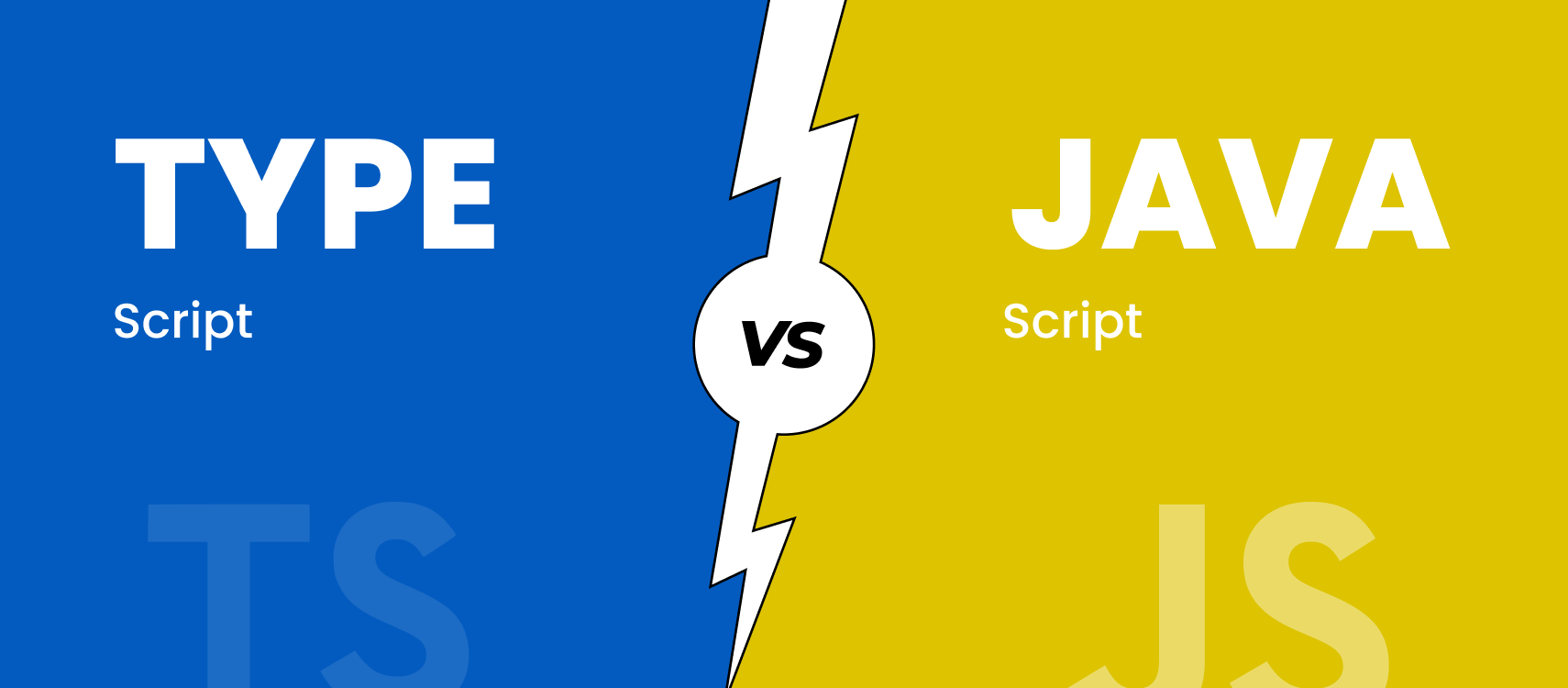Table of Contents
- Understanding JavaScript
- Difference TypeScript and JavaScript
- Advantages of TypeScript Over JavaScript
- Detailed: JavaScript vs. TypeScript
- Conclusion
If you’ve ever been involved in a web development project, you’ll already appreciate the versatility and impact of JavaScript. For decades, it has been one of the most widely used and respected scripting languages, forming the backbone of numerous websites and applications.
Yet, in the fast-paced world of technology, no language remains unchallenged for long. As one leads the way, another inevitably emerges to compete. In recent years, that challenger has been TypeScript.
Often described as JavaScript’s more refined and structured counterpart, TypeScript has experienced rapid growth in popularity. Seen by many as an enhanced version of JavaScript, it introduces additional features and improvements that make it particularly well-suited for developing larger, more complex applications.
In this blog, we will do a detailed of TypeScript and JavaScript, exploring their key differences and advantages of these languages as web development solutions.
Understanding JavaScript
JavaScript is a versatile, high-level, interpreted programming language that was created primarily for web development. It’s supported by all major web browsers, making it the go-to language for client-side scripting. Over the years, JavaScript has evolved significantly and now plays a vital role in both front-end and back-end development. Today, Node.Js development solutions can meet both your frontend and backend requirements.
Ready to make the right choice?
Get in touch today for a free consultation and take the first step towards building a future-proof application.
Consult with ExpertsDifference Between TypeScript and JavaScript
While both TypeScript and JavaScript are widely used for web development, they have distinct differences in features, syntax, and use cases. TypeScript is often regarded as an object-oriented, statically typed superset of JavaScript, offering additional tools for building large, complex applications. JavaScript, on the other hand, is a prototype-based, dynamically typed scripting language that remains the core technology of the web.
Below is a detailed side-by-side comparison:
| Feature | TypeScript | JavaScript |
| Programming Paradigm | Object-oriented language that builds upon JavaScript | Prototype-based scripting language |
| Typing | Statically typed types are checked at compile-time | Dynamically typed types are determined at runtime |
| Syntax | Similar to JavaScript but with additional features such as type annotations, interfaces, and generics | Standard JavaScript syntax without type annotations |
| Tooling Support | Excellent tooling with advanced autocompletion, refactoring, and error detection in modern IDEs | Limited built-in tooling; relies on browser dev tools and editor extensions |
| Interfaces | Fully supports interfaces and custom type definitions | No native support for interfaces |
| Error Detection | Errors are caught at compile-time, reducing runtime issues | Errors are detected only at runtime, which can lead to more debugging |
| Compatibility | Fully backward-compatible with JavaScript existing JavaScript code can be used in TypeScript projects | Cannot execute TypeScript code directly without transpilation |
| Compilation | Must be compiled (transpiled) into JavaScript before running in browsers or Node.js | Interpreted directly by browsers and Node.js without compilation |
| Debugging | Strong type checking helps identify issues early; source maps allow easier debugging | May require more extensive runtime testing to catch issues |
| Learning Curve | Steeper learning curve due to additional features and concepts | Easier to learn for beginners as it uses standard JavaScript syntax |
| Scalability | Designed for large-scale applications with multiple developers | Best suited for small to medium-sized projects, though it can be scaled with discipline |
| Community & Ecosystem | Growing rapidly with strong support from Microsoft and major frameworks (e.g., Angular) | Very large and mature ecosystem with universal browser support |
| Use in Frameworks | Popular in frameworks like Angular, NestJS, and increasingly in React projects | Used everywhere including React, Vue.js, Angular, and vanilla JS projects |
| Performance | Same runtime performance as JavaScript (compiled output is JavaScript) | Native execution in browsers baseline performance for the web |
Advantages of Using TypeScript Over JavaScript
TypeScript has rapidly grown in popularity in the TypeScript development services community, especially for large-scale and complex projects. As a superset of JavaScript, it introduces powerful features that improve code quality, scalability, and maintainability, all while compiling down to JavaScript for universal compatibility.
Here are the key advantages TypeScript offers over JavaScript:
| Advantage | TypeScript | JavaScript | Benefit in Real Projects |
| Static Typing | Supports static typing with explicit type declarations, enabling the compiler to detect type errors before runtime. | Dynamically typed; type errors only appear at runtime. | Reduces runtime bugs and improves overall code reliability. |
| Early Error Detection | Errors are caught during compilation, before execution. | Errors often surface only during testing or production. | Saves time, reduces testing costs, and prevents production issues. |
| Code Maintainability | Clear type annotations and interfaces make refactoring safe and predictable. | Refactoring may introduce subtle bugs that go unnoticed. | Ideal for long-term projects with evolving requirements. |
| Enhanced IDE Support | Provides rich IntelliSense, autocomplete, and real-time feedback in modern editors (e.g., VS Code, WebStorm). | Limited autocomplete and error detection. | Improves developer productivity and reduces debugging effort. |
| Readable, Self-Documenting Code | Types act as inline documentation for functions, variables, and objects. | Requires external documentation or detailed comments. | New developers can understand code without extra onboarding time. |
| Modern JavaScript Features | Supports the latest ECMAScript features and compiles them for compatibility with older environments. | Limited by the runtime environment’s feature support. | Enables developers to use modern syntax without browser compatibility concerns. |
| Interfaces and Generics | Includes interfaces, generics, and advanced type systems for scalable code. | Lacks built-in interface and generic support. | Encourages reusable, flexible, and type-safe components. |
| Large-Scale Application Support | Strong typing and modular design suit enterprise-grade projects with multiple teams. | Risk of miscommunication and inconsistent code in large teams. | Maintains consistency across distributed development teams. |
| Backward Compatibility | All valid JavaScript is valid TypeScript; can be adopted incrementally. | Cannot run TypeScript without compilation. | Allows gradual migration from JavaScript to TypeScript without major rewrites. |
| Safer Refactoring | Automated refactoring tools work reliably due to static typing. | Higher risk of breaking changes going unnoticed. | Minimises human error during major code changes. |
| Strong Collaboration | Shared .d.ts files define consistent data contracts between frontend and backend. | No built-in mechanism for shared type definitions. | Reduces mismatches in API data structures. |
| Framework Integration | First-class support in major frameworks (Angular, React, Vue, NestJS). | Fully supported but without static typing advantages. | Seamless integration with modern tech stacks. |
| Ecosystem and Tooling | Rich ecosystem of type definitions, linters, and build tools. | Smaller ecosystem for static type safety tools. | Improves code quality and project scalability. |
| Long-Term Stability | Enforces consistent coding patterns, keeping codebases maintainable for years. | Dynamic typing can lead to “code rot” over time. | Reduces technical debt in legacy projects. |
| Developer Confidence | Provides compile-time guarantees that code behaves as expected. | Relies on unit tests and runtime checks. | Fewer surprises in production environments. |
| Better API Integration | Can auto-generate API clients from OpenAPI/Swagger definitions with type safety. | Requires manual data validation. | Speeds up integration and ensures correct API usage. |
| Reduced Bugs in Production | Many logic and type issues are caught before deployment. | Bugs may appear after release due to lack of type enforcement. | Increases application reliability and user satisfaction. |
JavaScript vs. TypeScript: A Detailed Comparison
Now that we have a basic understanding of JavaScript and TypeScript, let’s go deeper into their differences, and specific advantages for web and mobile app development projects.
Type System
- JavaScript: JavaScript is a dynamically typed language, meaning that variable types are determined at runtime. This flexibility allows for rapid development but can lead to type-related bugs that may not be detected until runtime.
- TypeScript: TypeScript introduces static typing, allowing developers to declare variable types at compile-time. This provides early error detection and better code documentation. While it may require additional typing, it significantly reduces runtime errors.
Tooling and IDE Integration
- JavaScript: JavaScript’s tooling and IDE integration are good but not as extensive as TypeScript’s. While you can use text editors and integrated development environments, you may miss out on some advanced features provided by TypeScript-aware IDEs.
- TypeScript: TypeScript offers exceptional tooling support, including code completion, intelligent suggestions, and strong integration with popular IDEs like Visual Studio Code. This enhances productivity and code quality.
Learning Curve
- JavaScript: JavaScript’s learning curve is generally considered to be lower, especially for beginners. Its straightforward syntax and dynamic typing make it accessible to those new to programming.
- TypeScript: TypeScript introduces additional concepts like type annotations and interfaces, which can increase the learning curve, especially for developers with no prior experience in statically typed languages.
Project Size and Complexity
- JavaScript: JavaScript is suitable for both small and large projects. However, as the project size and complexity increase, the absence of static typing may lead to more challenging debugging and maintenance.
- TypeScript: TypeScript excels in larger, more complex projects, as its static typing and strong tooling support aid in managing codebases effectively. It shines in scenarios where codebase maintainability is paramount.
Community and Ecosystem
- JavaScript: JavaScript has a vast and mature ecosystem with numerous libraries, frameworks, and packages. It enjoys broad community support, making it easy to find solutions to common problems.
- TypeScript: TypeScript benefits from JavaScript’s ecosystem and community while offering additional advantages. Although TypeScript-specific libraries and frameworks are fewer in number, the TypeScript community is growing rapidly.
Browser Compatibility
- JavaScript: JavaScript is supported by all modern web browsers, making it a universally compatible choice for client-side scripting.
- TypeScript: TypeScript code is transpiled into JavaScript, ensuring compatibility with all browsers, just like JavaScript.
Performance
- JavaScript: JavaScript code is typically executed directly by web browsers, leading to good runtime performance. However, the absence of static typing may result in runtime errors that affect performance.
- TypeScript: TypeScript code is transpiled into JavaScript, and type checking occurs at compile-time, which can lead to optimized code and improved runtime performance. Additionally, TypeScript’s type system can help prevent certain types of performance-related bugs.
Maintenance and Debugging
- JavaScript: JavaScript projects may require more effort in debugging and maintenance due to the absence of static typing. However, modern debugging tools and techniques help streamline this process.
- TypeScript: TypeScript’s static typing and early error detection contribute to easier maintenance and debugging. It reduces the likelihood of certain classes of bugs that are common in JavaScript.
Conclusion
After exploring the differences between TypeScript and JavaScript, it’s clear that both have their strengths and weaknesses.
TypeScript is an excellent choice for developers who value clean, structured, and highly readable code. Its features, such as static typing and real-time error checking, make it especially appealing for large-scale or complex projects where maintainability is a priority.
JavaScript, on the other hand, remains one of the most widely adopted languages in the world. While it may not offer the advanced features of TypeScript, it integrates seamlessly with HTML and CSS, making it perfect for enhancing web pages. The vast pool of skilled JavaScript developers also means you’ll never struggle to find talent.
One thing to keep in mind is that TypeScript, like JavaScript, isn’t natively supported by all browsers; it needs to be compiled into JavaScript before deployment.
If you’re unsure which technology best fits your project, the safest approach is to seek professional guidance. Our experienced front-end development team can help you assess your requirements, weigh the pros and cons, and choose the most suitable language for your goals.










